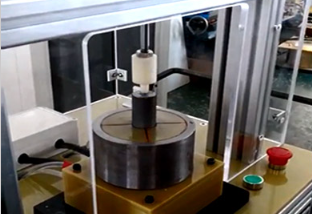How to analyze and troubleshoot brushless motor motor automatic rotor magnetizer?
Brushless motor motor automatic rotor magnetizer failure will affect the production efficiency and product quality, the following is from the electrical system, mechanical system, control system and software system several aspects of fault analysis and troubleshooting methods:
First, the electrical system failure
1, power failure
Failure phenomenon: the magnetizer can not start, the power indicator does not light.
Analysis and troubleshooting: first check whether the external power supply is normal, such as whether the power socket is energized, whether the fuse is blown. If the external power supply is normal, then check whether the power switch and power cord inside the magnetizer are damaged or loose. You can use a multimeter to measure the power supply voltage and line breakage.
Solution: Repair or replace the damaged power line, power switch, replace the blown fuse.

2、Failure of magnetizing circuit
Failure phenomenon: insufficient or unstable magnetizing strength, poor magnetizing effect.
Analysis and troubleshooting: Check whether the magnetizing capacitor is damaged, and whether the capacitor's capacity and voltage resistance meet the requirements. Also need to check whether the magnetizing coil has a short circuit, broken circuit, can use insulation resistance meter and multimeter for testing. In addition, check whether the contactors, relays and other switching elements in the magnetizing circuit work normally.
Solution: Replace the damaged capacitor, magnetizing coil, repair or replace the faulty switching elements.
3、Sensor failure
Failure phenomenon: the parameters displayed by the magnetizer are inaccurate, such as temperature, current, position and so on.
Analysis and troubleshooting: Check whether the installation position of the sensor is correct, whether it is loose or damaged. Use professional sensor testing equipment to test the sensor and determine whether it is working properly. Check whether the connecting wire of the sensor is broken or has poor contact.
Solution: Reinstall or adjust the sensor position, replace the damaged sensor, repair or replace the connecting wire.
Second, the mechanical system failure
1, rotor clamping failure
Failure phenomenon: the rotor is not firmly clamped, displacement occurs in the process of magnetization, resulting in uneven magnetization.
Analysis and troubleshooting: Check whether the rotor clamp is worn or deformed, and whether the clamping force is sufficient. Check whether the driving mechanism of the fixture is working properly, such as cylinder, motor, etc.
Solution: Replace the worn or deformed fixture, adjust the clamping force of the fixture, repair or replace the faulty drive mechanism.
2、Drive mechanism failure
Failure phenomenon: the drive components of the magnetizer does not run smoothly, there is a strange sound or jamming phenomenon.
Analysis and troubleshooting: Check whether the transmission belt is loose and worn, whether the chain is slack and broken, and whether the gear is worn and poorly meshed. Check the lubrication of the transmission mechanism, whether the lack of lubricant.
Solution: adjust the belt tension, replace the worn belt, chain and gears, add or replace the lubricant.
3, guide rail and slider failure
Failure phenomenon: the rotor does not move smoothly in the process of magnetization, positional accuracy is reduced.
Analysis and troubleshooting: Check the guide rail and slider for wear and deformation, and whether there is debris or oil on the surface of the guide rail. Check the lubrication and fastening of the slider.
Solution: Repair or replace the worn guide rail and slider, clean the debris and oil on the surface of the guide rail, add lubricant and fasten the slider.
Third, the control system failure
1、Control board failure
Failure phenomenon: the magnetizer can not be magnetized according to the preset program, the control function fails.
Analysis and troubleshooting: Check whether the electronic components on the control board are damaged, such as chips, capacitors, resistors and so on. Check whether the connecting wires of the control board are loose or have poor contact. Use professional testing equipment to test the control board to determine whether it is working properly.
Solution: Replace the damaged electronic components, reconnect the loose connecting wires, repair or replace the faulty control board.
2、Program failure
Failure phenomenon: the operation interface of the magnetizer shows abnormalities and the program runs wrong.
Analysis and troubleshooting: Check whether the control program has been mistakenly modified or damaged, and whether there are software loopholes. You can try to restart the magnetizer to see if it can return to normal.
Solution: Reload the correct control program, update the software version and repair the software vulnerability.
Fourth, the software system failure
1、Data display and processing fault
Failure phenomenon: The data on the display of the magnetizer is displayed incorrectly, or the collected data cannot be processed correctly.
Analysis and troubleshooting: Check whether there are failures in the software system, such as program crash and data loss. Check whether the data acquisition module and transmission line are working normally.
Solution: Restart the software system to recover the lost data and repair the software failure. Check and repair the problems of data acquisition module and transmission line.
2、Communication Failure
Failure phenomenon: the magnetizer and external equipment (such as the host computer, sensors, etc.) can not communicate normally.
Analysis and troubleshooting: Check whether the communication line is connected correctly and whether it is damaged or loose. Check whether the communication protocol is set correctly and whether the communication interface works normally.
Solution: Reconnect the communication lines and replace damaged lines. Check and adjust the communication protocol, and repair or replace the malfunctioning communication interface.
When analyzing and troubleshooting the fault, follow the principle of first easy then difficult, first outside then inside, gradually narrow down the scope of the fault, find the root cause of the fault and solve it.
※ If the above ways and means still can't solve the equipment failure, please contact the technical specialist of Xinhui Electromechanical Equipment Co.







